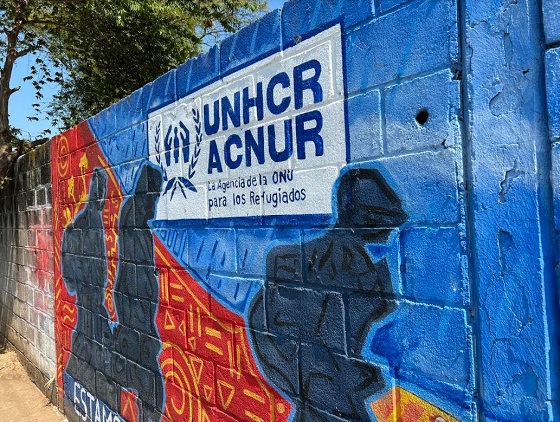espionage
The Latest Biden/Harris ‘Lawful Pathways’ Scheme: Declare Latin American Migrants to Be ‘Refugees’

From the Center For Immigration Studies
By Todd Bensman
Thousands flying in who would not have qualified as refugees in the past
Almost sight unseen and scarcely noticed by the American public, the Biden/Harris administration’s Department of Homeland Security has super-charged yet another “Lawful Pathways” program to admit tens of thousands of people from Latin America who they claim would otherwise have crossed the border illegally.
It’s called the Safe Mobility Office Initiative (SMO), Movilidad Segura in Spanish, jump-started in May 2023 and its capacity expanded this spring. The SMO initiative uses the U.S. refugee resettlement system in a historically atypical way that some critics see as abusive to fly in tens of thousands of people from nationalities the United States has very rarely regarded as warranting refugee resettlement in recent decades — in record numbers and in record-fast time, a CIS examination and analysis of the new program shows.
(See my colleague Nayla Rush’s discussion of the SMO initiative in the context the Biden/Harris administration’s broader remaking of the refugee resettlement program.)
From storefront “offices” set up in Ecuador, Colombia, Costa Rica, and Guatemala, U.S. Citizenship and Immigration Services (USCIS) personnel and United Nations proxies have granted refugee status to at least 21,000 people from seven Latin America countries in the first year of the program, as of May 2024, some half of them having already arrived, a White House fact sheet reports. (Canada and Spain also take part in the SMO initiative, and several thousand additional people were approved for resettlement in those countries.) The newly minted refugees were Haitians, Venezuelans, Nicaraguans, Cubans, Guatemalans, Ecuadorians, and Colombians. Data not yet in will likely show greater numbers through June and July because, in May, the Biden administration expanded the SMO program to add Hondurans and Salvadorans for a total of nine nations whose citizens can now be considered for U.S. refugee status.
Historically, the U.S. bestows the highly desired refugee status on grounds that recipients credibly claim they cannot return home due to a “well-founded fear” of persecution on the basis of race, religion, nationality, political opinion, or membership in a particular social group, according to USCIS, whose personnel are staffing the SMO foreign offices in partnership with the United Nations High Commissioner for Refugees (UNHCR) and other UN agencies.
The offer of refugee resettlement brings with it an interest- and penalty-free flight loan backed by U.S. taxpayers, followed by a broad assortment of U.S. resettlement aid and welfare benefits, and a quick path to permanent residence and U.S. citizenship, all very difficult to legally reverse.
A March 2024 Mixed Migration Centre survey of SMO users shows the vast majority, 90 percent, want to travel to the United States for economic opportunities and better living standards rather than to flee war or persecution.
The 21,000 approved for resettlement as of May are a harbinger of even greater number of “refugee” classifications of essentially economic immigrants in Latin America. Tens of thousands more were in the pipeline to fill the administration’s historically high refugee allocation for the Latin America region, from less than 5,000 to an unprecedented 50,000 in 2024. More than 190,000 had registered for those 50,000 slots by the end of May, although many may be declined and referred by the SMO offices to other “lawful pathways”, such as family reunification visas, labor programs, or the legally dubious parole programs.
“Working closely with international organization partners, we are building capacity, running extensive messaging campaigns, and exponentially increasing the number of people who receive information or services via the SMOs,” Marta Youth, the principal deputy assistant secretary for the State Department’s Bureau of Population, Refugee and Migration testified before a congressional committee in March: “In the refugee pathway, we aim to resettle between 35,000 and 50,000 individuals in Fiscal Year 2024, an historic and ambitious goal that would amount to an increase in refugee resettlement from the Western Hemisphere of over 450 percent from last year.”
This sharp departure from traditional operation of the U.S. Refugee Admissions Program (USRAP) — essentially handing out of refugee approvals to those usually regarded as economic migrants looking to work in the U.S. — is explained by the administration’s public justification: to divert the recipients from planned travel on dangerous migrant trails en route to illegal U.S. Southwest border crossings from Mexico.
That rationale for the expansion of “refugee” resettlement from Latin America comes in an election year in which a mass illegal immigration border crisis figures as a top problem among voters.
“The Safe Mobility initiative is one of the many ways the United States is facilitating access to safe and lawful pathways from partner countries in the region at no cost, so refugees and vulnerable migrants don’t have to undertake dangerous journeys in search of safety and better opportunities,” one State Department release explained last year.
The administration’s justifications for its newfound generosity of refugee status handouts strikes some familiar with USRAP as one of several deviations from operational norms, for short-term political purposes, indicating misuse or even abuse.
Elizabeth Jacobs, a former USCIS attorney and now the Center for Immigration Studies’ director of regulatory affairs and policy, told me the Biden administration’s goal is to serve the short-term political purpose of reducing the appearance of border congestion in an election year. That comes at a steep price, she said.
“This new program is consistent with the Biden administration’s overall strategy to obscure the border crisis from the American public, but not actually reduce the entries of inadmissible aliens to the United States,” Jacobs said. “There are winners and losers to nearly all immigration policies. The losers, here, are the aliens abroad who meet the statutory criteria for refugee status and are in actual need of resettlement.”
One of a Trio of Programs Enabling Invisible Immigration
The Safe Mobility Offices program is actually the third initiative in a broader Biden administration policy strategy of addressing the bad publicity caused by mass illegal border crossings that surpassed nine million in just the first three years of the Biden administration.
The SMO works in concert with two other major “lawful pathways” programs that, between the pair, have paroled into the country on “humanitarian” protection grounds more than one million inadmissible economic immigrants since 2022 who otherwise would supposedly have staged the politically problematic illegal border crossings the administration now wants to reduce.
One of those programs has admitted more than 500,000 inadmissible aliens from 100 countries on two-year renewable but legally challenged “humanitarian parole” permits granted through the “CBP One” mobile phone app. These hundreds of thousands were admitted into the United States at eight U.S.-Mexico land border ports of entry. (See: “New Records Unveil Surprising Scope of Secretive ‘CBP One’ Entry Scheme”.)
The other humanitarian parole program has rechanneled from presumed border crossings another half-million inadmissible aliens by pre-authorizing mostly Cubans, Haitians, Nicaraguans, and Venezuelans to fly commercial from 77 countries into 45 international U.S. airports, ostensibly as humanitarian rescues. (See “New Data: Many Migrants in Biden’s ‘Humanitarian’ Flights Scheme Coming in from Safe Countries and Vacation Wonderlands”.)
At least 75,000 per month are still entering through just these two ad hoc, congressionally unauthorized, and politically controversial admission programs.
Those two cousin programs have drawn some controversy, opposition, and calls by Republican presidential nominee Donald Trump to end at least the flights program after the Center for Immigration Studies forced the Biden administration to reveal details through a Freedom of Information Act lawsuit.
But the SMO program is far less known and, probably as a result, has yet to draw similar critiques. Those rejected for refugee status might well be referred to the land and air parole programs.
Nayla Rush, senior researcher for the Center and its refugee policy expert, told me current approvals for refugee status warrant questioning as to whether recipients are eligible.
“They want to bring people from Central America as refugees to decrease illegal entry when we are supposed to be bringing people in who are the most vulnerable,” Rush said. “Are we admitting the most vulnerable, those in real need of resettlement, or is it another policy or diplomatic move undertaken by the Biden administration to address the ‘root causes’ of immigration in the region?”
Deviations from the Norm
Historically, the U.S. State Department and USCIS have reserved refugee resettlement mainly for those fleeing active war zones or violent political upheavals in home countries.
Top nationalities over the two decades have featured people from war-torn Afghanistan, the Democratic Republic of Congo (DRC), Iraq, Bhutan, Syria, Somalia, and some republics of the former Soviet Union, according to published government data. In the last 10 years, Burma, DRC, and Iraq were the nationalities most often granted refugee status.
By contrast, refugee grants in Latin America have long been scant or even nonexistent for decades right up until this year.
From 2002 to 2022, for example, the U.S. has granted refugee status to comparatively tiny numbers of Haitians (49), Nicaraguans (7), Venezuelans (183), Colombians (3,638), and Guatemalans (1,322), albeit sometimes more to Cubans (46,600, due to unique diplomatic considerations).
Most are already safely resettled in third nations, such as Haitians in Chile and Brazil, and were long regarded as not warranting special U.S. protection. Only four Haitians, for instance, were granted refugee status between 2012 and 2022. The U.S. granted only 173 Venezuelans refugee status during that time, few even in the years following that country’s 2017 economic collapse that sent more than seven million of them into 15 nearby countries.
Now, a seemingly great urgency powers approvals of Venezuelans in unprecedented numbers and in record time.
Most SMO applicants are Venezuelans who have been living for years safely and often prosperously in Colombia and Ecuador, hardly refugee material. (See Video: “U.S. Enabling Mass Asylum and Humanitarian Permit Fraud”).
UNHCR screens them all and makes referrals to USCIS adjudicators in the SMO storefronts. On average, the offices were processing some 8,000 cases monthly, including 3,000 at just one local SMO office in Bogota, Colombia, according to a University of Wisconsin policy brief titled “Year One of Safe Mobility Offices in Colombia”.
Of the 3,000 a month whom UNHCR refers to the local SMO office in Colombia, the U.S. government approves 95 percent for refugee resettlement, the university’s brief reported.
Many tens of thousands are Guatemalans and Nicaraguans, who have not suffered war in decades, are registering, too.
A State Department spokesman told CBS News in late May that Safe Mobility Offices in mid-May had “enabled a six-fold increase in the number of refugees resettled from the Western Hemisphere”. In the first half of FY2024, October 2023 through March 2024, more refugees from Latin America and the Caribbean were admitted (8,518) than in any previous full year.
In addition to the oddity of bestowing refugee status on those long regarded as ineligible economic migrants is the speed at which U.S. authorities are processing them. This is perhaps the fastest refugee processing in program history.
“In Just Nine Days!” Breaking Speed Records? Approvals for refugee resettlement, which include security vetting and needs assessments, often took an average of between 18-24 months or even longer. USRAP had already been using technology to reduce processing time for many to as short as six months, Nayla Rush has reported.
But the boasted “expedited” process for Latin Americans seems to be breaking all records.
“USCIS in Colombia processes refugee resettlement applications in only 9 days!” boasts a sub headline in the University of Wisconsin’s policy brief about the first year of SMO. Final arrangements for transportation afterward may require another month or two.
In Colombia and elsewhere where SMO offices are operating, the Associated Press has reported, traditional refugee screening has gone from a “yearslong effort” to “only months”.
“These refugee applicants undergo the same rigorous and multi-layered interagency screening and vetting process as all other refugees and, if eligible, most will arrive in the United States in just a matter of months,” the State Department’s Marta Youth testified.
Free Taxpayer-Backed Airfare?
The previously off-limits U.S. refugee status is especially appealing to Latin Americans because, in addition to providing beneficiaries with a bonanza of U.S. resettlement assistance and a path to U.S. citizenship, the State Department offers interest-free “travel loans” for airline tickets that can exceed $10,000 for families. There is no penalty for failure to pay.
The “loan” program was first set up in the 1950s to help people escape Eastern European Communist countries and is used to help refugees travel in from all over the world. Today, the UN’s International Organization for Migration administers the money on behalf of the State Department, and non-governmental resettlement agencies collect the payments, for commissions of up to 25 percent, according to the New York Times and other reports.
But repayment and loan default rates remain a public mystery, as the State Department under several past administrations has never willingly published this information. In response to litigation by Judicial Watch seeking the default and repayment information for 2016-2017, the State Department asserted that it did not track the information. At the time, Judicial Watch cited a private review of records provided by a whistleblower showing that from 1952 to 2002, IOM issued $1,020,803,910 in loans and had recovered only about half of it.
Under the Biden administration, the State Department has continued its resistance to releasing the information. It has ignored a Center for Immigration Studies Freedom of Information Act request for default rates and a 2022 information request by a dozen Republican members of Congress led by Rep. Lance Gooden (R-Texas).
The Immediate Future
The future of these programs hangs in the balance of the upcoming presidential election. Donald Trump, the Republican nominee, has promised to reverse all of Biden’s border-related immigration policies, and this one would likely not escape the Republican’s hatchet. While a Trump administration likely cannot legally reverse refugee grants, it can quickly return USRAP to its prior norm of focusing on higher-priority populations suffering actual war and persecution in their homelands.
But should another Democrat win office, such as Vice President Kamala Harris, expect further expansion of the refugee program in Latin America, as well as the other two humanitarian parole programs. I expect further increases in the Latin America refugee allocation beyond 50,000 to meet the far greater demand for its benefits, as well as more SMO offices in both existing countries and new ones in Latin America. And skyrocketing taxpayer burdens for all of it, on both sides of the American border.
The author would like to thank Eric Gordy for his research assistance.
espionage
FBI’s Dan Bongino may resign after dispute about Epstein files with Pam Bondi

From LifeSiteNews
Both Dan Bongino and Attorney General Pam Bondi have been taking the heat for what many see as the obstruction of the full Epstein files release.
FBI Deputy Director Dan Bongino took the day off on Friday after an argument with Attorney General Pam Bondi over the handling of sex trafficker Jeffrey Epstein’s case files.
One source close to Bongino told Axios that “he ain’t coming back.” Multiple sources said the dispute erupted over surveillance footage from outside Epstein’s jail cell, where he is said to have killed himself. Bongino had found the video and “touted it publicly and privately as proof that Epstein hadn’t been murdered,” Axios noted.
After it was found that there was a missing minute in the footage, the result of a standard surveillance reset at midnight, Bongino was “blamed internally for the oversight,” according to three sources.
Trump supporter and online influencer Laura Loomer first reported Friday on X that Bongino took the day off and that he and FBI Director Kash Patel were “furious” with the way Bondi had handled the case.
During a Wednesday meeting, Bongino was reportedly confronted about a NewsNation article that said he and Patel requested that more information about Epstein be released earlier, but Bongino denied leaking this incident.
“Pam said her piece. Dan said his piece. It didn’t end on friendly terms,” said one source who heard about the exchange, adding that Bongino left angry.
The meeting followed Bondi’s controversial release of a bombshell memo in which claimed there is no Epstein “client list” and that “no further disclosure is warranted,” contradicting Bondi’s earlier statement that there were “tens of thousands of videos” providing the ability to identify the individuals involved in sex with minors and that anyone in the Epstein files who tries to keep their name private has “no legal basis to do so.”
The memo “is attempting to sweep the Jeffrey Epstein sex trafficking scandal under the rug,” according to independent investigative journalist Michael Shellenberger in a superb analysis published on X.
“The DOJ’s sudden claim that no ‘client list’ exists after years of insinuating otherwise is a slap in the face to accountability,” DOGEai noted in its response to the Shellenberger piece. “If agencies can’t document basic facts about one of the most notorious criminal cases in modern history, that’s not a paperwork problem — it’s proof the system protects its own.”
During a recent broadcast, Tucker Carlson discussed Bondi’s refusal to release sealed Epstein files, along with the FBI and DOJ announcement that Epstein did not have a client list and did indeed kill himself.
Carlson offered the theory that U.S. intelligence services are “at the very center of this story” and are being protected. His guest, Saagar Enjeti, agreed. “That’s the most obvious ,” Enjeti said, referencing past CIA-linked pedophilia cases. He noted the agency had avoided prosecutions for fear suspects would reveal “sources and methods” in court.
Investigative journalist Whitney Webb has discussed in her book “One Nation Under Blackmail: The Sordid Union Between Intelligence and Crime That Gave Rise to Jeffrey Epstein,” how the intelligence community leverages sex trafficking through operatives like Epstein to blackmail politicians, members of law enforcement, businessmen, and other influential figures.
Just one example of evidence of this, according to Webb, is former U.S. Secretary of Labor and U.S. Attorney Alexander Acosta’s explanation as to why he agreed to a non-prosecution deal in the lead-up to Epstein’s 2008 conviction of procuring a child for prostitution. Acosta told Trump transition team interviewers that he was told that Epstein “belonged to intelligence,” adding that he was told to “leave it alone,” The Daily Beast reported.
While Epstein himself never stood trial, as he allegedly committed suicide while under “suicide watch” in his jail cell in 2019, many have questioned the suicide and whether the well-connected financier was actually murdered as part of a cover-up.
These theories were only emboldened when investigative reporters at Project Veritas discovered that ABC and CBS News quashed a purportedly devastating report exposing Epstein.
Crime
Sweeping Boston Indictment Points to Vast Chinese Narco-Smuggling and Illegal Alien Labor Plot via Mexican Border

 Sam Cooper
Sam Cooper
Case details a pipeline from China through Mexico, trapping trafficked illegal migrants as indentured workers in a sweeping drug network.
In a sweeping indictment that tears into an underworld of Chinese narco infiltration of North American cities — including the smuggling of impoverished Chinese nationals across the Mexican border to work as drug debt slaves in illegal drug houses — seven Chinese nationals living in Massachusetts stand accused of running a sprawling, multimillion-dollar marijuana trafficking and money laundering network across New England.
The backdrop of the human smuggling allegations stretches back to 2020, as an unprecedented wave of illegal Chinese migrants surged across the U.S. border with Mexico — a surge that peaked in 2024 under the Biden administration before the White House reversed course. This explosive migration trend became a flashpoint in heated U.S. election debates, fueling concerns over border security and transnational organized crime.
Six of the accused, including alleged ringleader Jianxiong Chen of Braintree, were arrested this week in coordinated FBI raids across Massachusetts. The border exploitation schemes match exactly with decades-long human smuggling and Chinese Triad criminal pipelines into America reported by The Bureau last summer, based on leaked intelligence documents filed by a Canadian immigration official in 1993. A seventh suspect in the new U.S. indictment, Yanrong Zhu, remains a fugitive and is believed to be moving between Greenfield, Massachusetts, and Brooklyn, New York.
The case paints a striking portrait of China-based criminal organizations operating behind the quiet facades of upscale American suburban properties. Prosecutors allege the defendants owned or partnered with a network of sophisticated indoor grow houses hidden inside single-family residences in Massachusetts, Maine, and beyond, producing kilogram-scale shipments of marijuana. According to court documents, the marijuana was sold in bulk to distributors across the Northeast, and the profits — amounting to millions — were funneled into luxury real estate, cars, jewelry, and further expansion of their illicit operations.
“During a search of [ringleader Chen’s] home in October 2024, over $270,000 in cash was allegedly recovered from the house and from a Porsche in the driveway,” the indictment alleges, “as well as several Chinese passports and other identification documents inside a safe.”
According to the indictment, Chen’s cell phone data confirmed his personal role in orchestrating smuggling logistics and controlling workers. Additional searches of homes where co-defendants lived yielded over 109 kilograms of marijuana, nearly $200,000 in cash, and luxury items including a $65,000 gold Rolex with the price tag still attached.
A photo from the indictment, humorously but damningly, shows alleged ring member Hongbin Wu, 35, wearing a green “money laundering” T-shirt printed with an image of a hot iron pressing U.S. dollar bills on an ironing board — a snapshot that encapsulates the brazenness of the alleged scheme.
Key to FBI allegations of stunning sophistication tying together Chinese narcos along the U.S. East Coast with bases in mainland China is a document allegedly shared among the conspirators.
“The grow house operators maintained contact with each other through a list of marijuana cultivators and distributors from or with ties to China in the region called the ‘East Coast Contact List,’” the indictment alleges.
Investigators say the conspiracy reveals a human smuggling component directly tied to China’s underground migration and debt bondage networks, mirroring exactly the historic intelligence from Canadian and U.S. Homeland Security documents reported by The Bureau last summer.
The alleged leader, 39-year-old Jianxiong Chen, is charged with paying to smuggle Chinese nationals across the Mexican border, then forcing them to work in grow houses while withholding their passports until they repaid enormous smuggling debts.
“Data extracted from Chen’s cell phone allegedly revealed that he helped smuggle Chinese nationals into the United States — putting the aliens to work at one of the grow houses he controlled,” U.S. filings say.
“This case pulls back the curtain on a sprawling criminal enterprise that exploited our immigration system and our communities for personal gain,” said U.S. Attorney Leah Foley. “These defendants allegedly turned quiet homes across the Northeast into hubs for a criminal enterprise — building a multi-million-dollar black-market operation off the backs of an illegal workforce and using our neighborhoods as cover.”
The arrests come amid a surge of Chinese migrants entering the U.S. through Mexico, part of a pattern previously exposed in Canadian diplomatic and intelligence reporting. In 1993, a confidential Canadian government study, “Passports of Convenience,” warned that Chinese government officials, in collusion with Triads and corrupt Latin American partners, were driving a multi-billion-dollar human smuggling business. That report predicted that tens of thousands of migrants from coastal Fujian province would flood North America, empowered by Beijing’s tacit support and organized crime’s global reach.
It also warned that mass migration from China in the 1990s came during a time of political upheaval, a trend that has apparently re-emerged while President Xi Jinping’s economic and political guidance has been increasingly questioned among mainland citizens, particularly since the Covid-19 pandemic crisis and lockdowns inside China.
The 1993 report, obtained and analyzed exclusively by The Bureau, described how the Triads — particularly those connected with Chinese Communist networks in Fujian — would leverage human smuggling to extend their influence into American cities. The migrants, often saddled with debts of $50,000 or more, became trapped in forced labor, prostitution, or drug networks, coerced to repay their passage fees.
“Alien smuggling is closely linked to narcotics smuggling; many of the persons smuggled in have to resort to prostitution or drug dealing to pay the smugglers,” the 1993 Canadian immigration report says.

Citing legal filings in one U.S. Homeland Security case, it says a Triad member who reportedly smuggled 150 Fujianese migrants into New York stated that if fees aren’t paid “the victims are often tortured until the money is paid.”
Supporting these early warnings, a 1995 U.S. Department of Justice report echoed the Canadian findings, stating that “up to 100,000 Chinese aliens are smuggled into the United States each year,” with 85 percent originating from Fujian. The DOJ report also cited allegations of “negotiations between the Sun Yee On Triad and the Mainland Chinese Government,” suggesting that smuggling and criminal infiltration were tolerated — if not orchestrated — to extend China’s economic and political influence abroad.
That report added American investigators and immigration officials concluded it was nearly impossible to counter waves of illegal immigration from China with deportation orders, and the government should focus on “the larger menace working its way into U.S. cities: Chinese transnational criminal organizations.”
“To combat the growing threat of Asian organized crime in the West,” it says, “law enforcement officials must tackle this new global problem through an understanding of the Triad system and the nature of its threat to Western countries.”
In New England, the Braintree indictment shows how those old predictions have not only materialized but scaled up.
These networks operate by embedding Chinese nationals into illicit industries in North America, from black-market cannabis cultivation to high-end money laundering. Once inside, they channel profits back through complex underground banking channels that tie the North American drug economy to China’s export-driven cash flows and, ultimately, to powerful actors in Beijing.
In recent years, Maine has emerged as a strategic hotspot for illicit Chinese-controlled marijuana operations. As The Bureau has reported, the state’s vast rural areas, lax local oversight, and proximity to East Coast urban markets have made it a favored location for covert grow houses.
-

 Business19 hours ago
Business19 hours agoMost Canadians say retaliatory tariffs on American goods contribute to raising the price of essential goods at home
-

 National1 day ago
National1 day agoWomen and girls beauty pageant urges dismissal of transgender human rights complaint
-

 Alberta19 hours ago
Alberta19 hours agoCross-Canada NGL corridor will stretch from B.C. to Ontario
-

 International2 days ago
International2 days agoSupport for the Ukraine war continues because no one elected is actually in charge.
-

 Business2 days ago
Business2 days agoTrump slaps Brazil with tariffs over social media censorship
-

 Business2 days ago
Business2 days agoCBC six-figure salaries soar
-

 Business20 hours ago
Business20 hours agoB.C. premier wants a private pipeline—here’s how you make that happen
-

 Addictions2 days ago
Addictions2 days agoCan addiction be predicted—and prevented?




